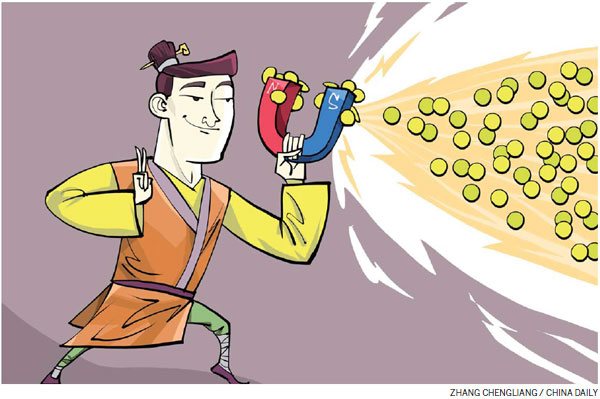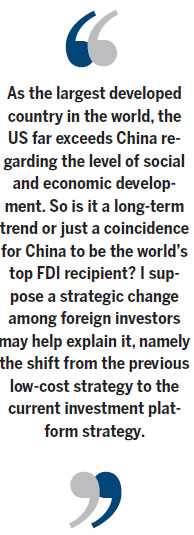China pulls itself to the top
Updated: 2015-04-03 07:28
By Li Guoxue(China Daily Europe)
|
|||||||||||
New Status as world's largest recipient of foreign direct investment reflects strategic changes
The Global Investment Trends Monitor, released by the United Nations Conference on Trade and Development on Jan 29, shows that four of the world's top five recipients of foreign direct investment are developing economies. China attracted a modest FDI increase of 3 percent to approximately $128 billion, including both financial and nonfinancial sectors, and became the world's largest FDI recipient for the first time. The top global FDI recipient in 2013, the United States, fell to third place in 2014.
FDI inflows to China in 2013 reached $124 billion, second to the US. It makes sense that China surpassed the US to become the world's top FDI recipient. Declining FDI in the US was mainly caused by the Federal Reserve's removal of its quantitative easing policy, the expectation of future interest rate increases, and the buy-back deal between Verizon and Vodafone. In particular, Verizon's buying back of shares, held by the UK's Vodafone Group, caused a considerable decline in equity investment in the US. FDI to the US dropped to an estimated $86 billion, and the net worth of cross-border mergers and acquisitions in the US slumped from $60 billion in 2013 to $10 billion in 2014.

However, against the backdrop of the global economic downturn and feeble recovery, the GDP growth of the US in 2014 unexpectedly reached 2.4 percent, the highest in four years. China's economy increased by 7.4 percent from the previous year, the lowest growth rate since 1990. In recent years, salaries and social security payments of Chinese industrial workers were much higher than those from Southeast Asia. Taxes on foreign enterprises and personal income tax also increased substantially, and China's low cost advantage became increasingly weakened. Furthermore, China's national security review of M&As by foreign investors became increasingly strict and concerns over the Diaoyu Island conflict and the South China Sea dispute affected foreign investors' interests in FDI in China. Some foreign enterprises even transferred their investment from China to some developing countries in Southeast Asia to take advantage of low labor costs.
The new rankings of China and the US are thought-provoking. As the largest developed country in the world, the US far exceeds China regarding the level of social and economic development. So is it a long-term trend or just a coincidence for China to be the world's top FDI recipient? I suppose a strategic change among foreign investors may help explain it, namely the shift from the previous low-cost strategy to the current investment platform strategy. As is reported in the Global Investment Trends Monitor, FDI in the Chinese manufacturing industry, especially Japanese investment and foreign investment in industries sensitive to the impact of higher labor costs, declined tremendously, while foreign investment in the service industry increased substantially.

As a result of Western countries' economic sanctions on Russia, foreign companies shifted more of their investment to emerging markets. The UNCTAD report indicated that due to regional conflicts, economic sanctions and the gloomy prospect of Russia's economy, investment by foreign investors (especially investors from developed countries) in Russia declined sharply. FDI flows to transitional economies fell by more than a half, amounting to approximately $45 billion. Regionally, developing countries in Asia enjoyed a significant increase in terms of FDI inflows; Africa maintained the previous level and Latin America declined to some extent.
However, compared with 2013, FDI flows to developing economies increased by 4 percent to a new high of over $700 billion, which accounts for 56 percent of the world market. China is likely to become the trading platform between Western companies and Russia. Last year, major Western economies imposed rounds of sanctions on Russia, including freezing assets and forbidding Russia from obtaining foreign capital through the capital market. In addition, American and European investors were not allowed to issue new loans to Sberbank, VTB Bank, GazpromBank, Rosselkhozbank and Vnesheconombank for longer than 30 days. As neighbors, the Sino-Russian relationship can be said to be the best among all relationships between great powers. Their ties were greatly developed in 2013. In 2014, their bilateral economic cooperation was further enhanced due to the Ukraine crisis. Russia's economic downturn and fluctuating currency also created great commercial opportunities. Foreign investors are always seeking favorable conditions, and China can be the best platform and springboard for Western enterprises to avoid the regulatory control of their own countries and to invest in Russia in the future. The implementation of the One Belt and One Road policy will make China another important platform for foreign companies to invest into countries along the ancient Silk Road.

One Belt and One Road runs through the whole of Eurasia. It borders on the Asia-Pacific Economic Circle on the East, and enters the European Economic Circle on the West. China's pivotal role helps it gain geographic advantages, thus becoming an important platform for foreign investment. The development and construction of One Belt and One Road creates a large market. Abundant natural resources can boost insufficient capital, human resources and under-developed infrastructure in countries along it. Investment in transportation, finance, energy, telecommunications, agriculture and tourism in these countries has great potential. It is reported that leaders across Asia have indicated their support for China's construction of One Belt and One Road.
A series of cooperation proposals have also been put into practice, including the China-Central Asia-West Asia Economic Corridor and the Bangladesh-China-India-Burma Economic Corridor. In the future, China will reach a set of agreements with countries along the Silk Road in terms of transport infrastructure, trade and investment, energy cooperation, regional integration and renminbi internalization. In addition, China will also reduce the costs and barriers of investment within the region, which will appeal to foreign investors.
The foreign investment policies in the Shanghai Free Trade Zone also provide an institutional guarantee for foreign investors who choose China as their investment platform. Investment liberalization and more investment protection provide institutional guarantees for the strategic shift of foreign investors.
The author is a senior research fellow at the Chinese Academy of Social Sciences. The views do not necessarily reflect those of China Daily.
( China Daily European Weekly 04/03/2015 page11)
Today's Top News
54 dead after Russian trawler sinks in ocean
Death toll rises to 147 in Kenya university attack
Dozens killed in Kenyan university attack
Video of final seconds aboard Germanwings plane discovered
British Prince Harry reports for duty in Australia next week
Chinese World War II veterans to receive medals from Russia
Lufthansa insurers set aside $300 mln over crash
Sarkozy makes political comeback
Hot Topics
Lunar probe , China growth forecasts, Emission rules get tougher, China seen through 'colored lens', International board,
Editor's Picks

|

|

|

|

|

|






